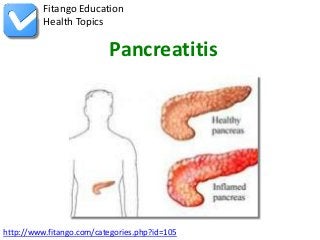
Pancreatitis
- 1. Fitango Education Health Topics Pancreatitis http://www.fitango.com/categories.php?id=105
- 2. Overview The pancreas is a large gland behind the stomach and close to the first part of the small intestine. It secretes digestive juices into the small intestine through a tube called the pancreatic duct. The pancreas also releases the hormones insulin and glucagon into the bloodstream. http://www.fitango.com/categories.php?id=105 1
- 3. Overview Pancreatitis is inflammation of the pancreas. It happens when digestive enzymes start digesting the pancreas itself. Pancreatitis can be acute or chronic. Either form is serious and can lead to complications. http://www.fitango.com/categories.php?id=105 2
- 4. Overview Acute pancreatitis occurs suddenly and usually goes away in a few days with treatment. It is often caused by gallstones. Common symptoms are severe pain in the upper abdomen, nausea, and vomiting. Treatment is usually a few days in the hospital for intravenous (IV) fluids, antibiotics, and medicines to relieve pain. http://www.fitango.com/categories.php?id=105 3
- 5. Overview Chronic pancreatitis does not heal or improve. It gets worse over time and leads to permanent damage. The most common cause is heavy alcohol use. Other causes include cystic fibrosis and other inherited disorders, high levels of calcium or fats in the blood, some medicines, and autoimmune conditions. Symptoms include nausea, vomiting, weight loss, and oily stools. Treatment may also be a few days in the hospital for intravenous (IV) fluids, medicines to relieve pain, and nutritional support. Aft http://www.fitango.com/categories.php?id=105 4
- 6. Symptoms Acute pancreatitis usually begins with gradual or sudden pain in the upper abdomen that sometimes extends through the back. The pain may be mild at first and feel worse after eating. But the pain is often severe and may become constant and last for several days. A person with acute pancreatitis usually looks and feels very ill and needs immediate medical attention. Other symptoms may include: http://www.fitango.com/categories.php?id=105 5
- 7. Symptoms -- a swollen and tender abdomen -- nausea and vomiting -- fever -- a rapid pulse http://www.fitango.com/categories.php?id=105 6
- 8. Symptoms Severe acute pancreatitis may cause dehydration and low blood pressure. The heart, lungs, or kidneys can fail. If bleeding occurs in the pancreas, shock and even death may follow. http://www.fitango.com/categories.php?id=105 7
- 9. Diagnosis While asking about a person's medical history and conducting a thorough physical examination, the doctor will order a blood test to assist in the diagnosis. During acute pancreatitis, the blood contains at least three times the normal amount of amylase and lipase, digestive enzymes formed in the pancreas. Changes may also occur in other body chemicals such as glucose, calcium, magnesium, sodium, potassium, and bicarbonate. After the person's condition improves, the levels usually return to norma http://www.fitango.com/categories.php?id=105 8
- 10. Diagnosis Diagnosing acute pancreatitis is often difficult because of the deep location of the pancreas. The doctor will likely order one or more of the following tests: **Abdominal ultrasound** http://www.fitango.com/categories.php?id=105 9
- 11. Diagnosis Sound waves are sent toward the pancreas through a handheld device that a technician glides over the abdomen. The sound waves bounce off the pancreas, gallbladder, liver, and other organs, and their echoes make electrical impulses that create a picture—called a sonogram—on a video monitor. If gallstones are causing inflammation, the sound waves will also bounce off them, showing their location. http://www.fitango.com/categories.php?id=105 10
- 12. Diagnosis **Computerized tomography (CT) scan** The CT scan is a noninvasive x ray that produces three-dimensional pictures of parts of the body. The person lies on a table that slides into a donut- shaped machine. The test may show gallstones and the extent of damage to the pancreas. http://www.fitango.com/categories.php?id=105 11
- 13. Diagnosis **Endoscopic ultrasound (EUS)** After spraying a solution to numb the patient's throat, the doctor inserts an endoscope—a thin, flexible, lighted tube—down the throat, through the stomach, and into the small intestine. The doctor turns on an ultrasound attachment to the scope that produces sound waves to create visual images of the pancreas and bile ducts. http://www.fitango.com/categories.php?id=105 12
- 14. Diagnosis **Magnetic resonance cholangiopancreatography (MRCP)** MRCP uses magnetic resonance imaging, a noninvasive test that produces cross-section images of parts of the body. After being lightly sedated, the patient lies in a cylinder-like tube for the test. The technician injects dye into the patient's veins that helps show the pancreas, gallbladder, and pancreatic and bile ducts. http://www.fitango.com/categories.php?id=105 13
- 15. Treatment Treatment for acute pancreatitis requires a few days' stay in the hospital for intravenous (IV) fluids, antibiotics, and medication to relieve pain. The person cannot eat or drink so the pancreas can rest. If vomiting occurs, a tube may be placed through the nose and into the stomach to remove fluid and air. http://www.fitango.com/categories.php?id=105 14
- 16. Treatment Unless complications arise, acute pancreatitis usually resolves in a few days. In severe cases, the person may require nasogastric feeding—a special liquid given in a long, thin tube inserted through the nose and throat and into the stomach—for several weeks while the pancreas heals. http://www.fitango.com/categories.php?id=105 15
- 17. Treatment Before leaving the hospital, the person will be advised not to smoke, drink alcoholic beverages, or eat fatty meals. In some cases, the cause of the pancreatitis is clear, but in others, more tests are needed after the person is discharged and the pancreas is healed. http://www.fitango.com/categories.php?id=105 16